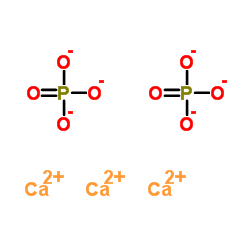Calcium phosphate

Calcium phosphate structure
|
Common Name | Calcium phosphate | ||
|---|---|---|---|---|
| CAS Number | 7758-87-4 | Molecular Weight | 310.177 | |
| Density | 3.14 | Boiling Point | 158ºC at 760 mmHg | |
| Molecular Formula | Ca3O8P2 | Melting Point | 1670°C | |
| MSDS | Chinese USA | Flash Point | N/A | |
|
Oncogene-mediated regulation of p53 ISGylation and functions.
Oncotarget 5(14) , 5808-18, (2014) Oncogene-mediated cellular transformation is a multistep process involving activation of growth-promoting pathways as well as inactivation of tumor suppressors. We recently found that ISGylation of the p53 tumor suppressor is an important novel mechanism to c... |
|
|
Neuropilin 1 is an entry factor that promotes EBV infection of nasopharyngeal epithelial cells.
Nat. Commun. 6 , 6240, (2015) Epstein-Barr virus (EBV) is implicated as an aetiological factor in B lymphomas and nasopharyngeal carcinoma. The mechanisms of cell-free EBV infection of nasopharyngeal epithelial cells remain elusive. EBV glycoprotein B (gB) is the critical fusion protein f... |
|
|
Epigenetic variation in the Egfr gene generates quantitative variation in a complex trait in ants.
Nat. Commun. 6 , 6513, (2015) Complex quantitative traits, like size and behaviour, are a pervasive feature of natural populations. Quantitative trait variation is the product of both genetic and environmental factors, yet little is known about the mechanisms through which their interacti... |
|
|
Crosstalk between VEGF and MTA1 signaling pathways contribute to aggressiveness of breast carcinoma.
Mol. Carcinog. 54(5) , 333-50, (2015) The expression of metastasis associated protein (MTA1) correlates well with tumor metastasis; however its role as a proangiogenic protein and the molecular mechanisms underlying the same are not fully understood. In this study the MTA1 protein was expressed a... |
|
|
Glycosylation of immunoglobulin G determines osteoclast differentiation and bone loss.
Nat. Commun. 6 , 6651, (2015) Immunglobulin G (IgG) sialylation represents a key checkpoint that determines the engagement of pro- or anti-inflammatory Fcγ receptors (FcγR) and the direction of the immune response. Whether IgG sialylation influences osteoclast differentiation and subseque... |
|
|
SapC-DOPS nanovesicles induce Smac- and Bax-dependent apoptosis through mitochondrial activation in neuroblastomas.
Mol. Cancer 14 , 78, (2015) High toxicity, morbidity and secondary malignancy render chemotherapy of neuroblastoma inefficient, prompting the search for novel compounds. Nanovesicles offer great promise in imaging and treatment of cancer. SapC-DOPS, a stable nanovesicle formed from the ... |
|
|
Chronic mild stress and antidepressant treatment alter 5-HT1A receptor expression by modifying DNA methylation of a conserved Sp4 site.
Neurobiol. Dis. 82 , 332-41, (2015) The serotonin 1A receptor (5-HT1A), a critical regulator of the brain serotonergic tone, is implicated in major depressive disorder (MDD) where it is often found to be dys-regulated. However, the extent to which stress and antidepressant treatment impact 5-HT... |
|
|
Enhancing Protein Expression in HEK-293 Cells by Lowering Culture Temperature.
PLoS ONE 10(4) , e0123562, (2015) Animal cells and cell lines, such as HEK-293 cells, are commonly cultured at 37°C. These cells are often used to express recombinant proteins. Having a higher expression level or a higher protein yield is generally desirable. As we demonstrate in this study, ... |
|
|
Calcium and phosphate release from resin-based materials containing different calcium orthophosphate nanoparticles.
J. Biomed. Mater. Res. B. Appl. Biomater. 103 , 1670-8, (2015) The study compared ion release from resin-based materials containing calcium orthophosphates. Amorphous calcium phosphate (ACP), dicalcium phosphate anhydrous (DCPA), dicalcium phosphate dihydrate (DCPD), and tricalcium phosphate (β-TCP) nanoparticles were ch... |
|
|
Routes of Ca2+ Shuttling during Ca2+ Oscillations: FOCUS ON THE ROLE OF MITOCHONDRIAL Ca2+ HANDLING AND CYTOSOLIC Ca2+ BUFFERS.
J. Biol. Chem. 290 , 28214-30, (2015) In some cell types, Ca(2+) oscillations are strictly dependent on Ca(2+) influx across the plasma membrane, whereas in others, oscillations also persist in the absence of Ca(2+) influx. We observed that, in primary mesothelial cells, the plasmalemmal Ca(2+) i... |